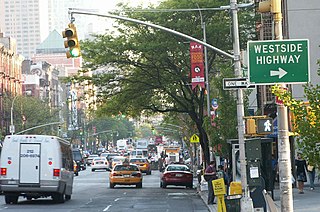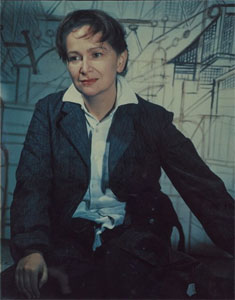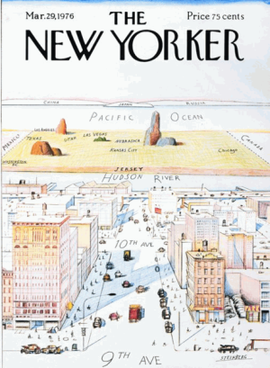
The New Yorker is an American magazine featuring journalism, commentary, criticism, essays, fiction, satire, cartoons, and poetry. It was founded on February 21, 1925, by Harold Ross and his wife Jane Grant, a reporter for The New York Times. Together with entrepreneur Raoul H. Fleischmann, they established the F-R Publishing Company and set up the magazine's first office in Manhattan. Ross remained the editor until his death in 1951, shaping the magazine's editorial tone and standards.

Manhattan is the most densely populated and geographically smallest of the five boroughs of New York City. The borough is coextensive with New York County, the smallest county by geographical area in the U.S. state of New York. Located almost entirely on Manhattan Island near the southern tip of the state, Manhattan constitutes the center of the Northeast megalopolis and the urban core of the New York metropolitan area. Manhattan serves as New York City's economic and administrative center and has been described as the cultural, financial, media, and entertainment capital of the world.

Chelsea is a neighborhood on the West Side of the borough of Manhattan in New York City. The area's boundaries are roughly 14th Street to the south, the Hudson River and West Street to the west, and Sixth Avenue to the east, with its northern boundary variously described as near the upper 20s or 34th Street, the next major crosstown street to the north. To the northwest of Chelsea is the neighborhood of Hell's Kitchen, as well as Hudson Yards; to the northeast are the Garment District and the remainder of Midtown South; to the east are NoMad and the Flatiron District; to the southwest is the Meatpacking District; and to the south and southeast are the West Village and the remainder of Greenwich Village. Chelsea is named after the Royal Hospital Chelsea in London, England.

Midtown Manhattan is the central portion of the New York City borough of Manhattan and serves as the city's primary central business district. Midtown is home to some of the city's most prominent buildings, including the Empire State Building, the Chrysler Building, the Hudson Yards Redevelopment Project, the headquarters of the United Nations, Grand Central Terminal, and Rockefeller Center, as well as several prominent tourist destinations including Broadway, Times Square, and Koreatown. Penn Station in Midtown Manhattan is the busiest transportation hub in the Western Hemisphere.

Moscow on the Hudson is a 1984 American romantic comedy-drama film, written and directed by Paul Mazursky, starring Robin Williams as a Soviet circus musician who defects while on a visit to the United States. It co-stars María Conchita Alonso, Elya Baskin as the circus clown, Savely Kramarov as one of two KGB apparatchiks, Alejandro Rey as the musician's immigration attorney, and Cleavant Derricks as his first American host and friend.

Curtis Arnoux Peters, Jr., known professionally as Peter Arno, was an American cartoonist. He contributed cartoons and 101 covers to The New Yorker from 1925, the magazine's first year, until 1968, the year of his death. In 2015, New Yorker contributor Roger Angell described him as "the magazine's first genius".
Saul Steinberg was an American artist, best known for his work for The New Yorker, most notably View of the World from 9th Avenue. He described himself as "a writer who draws".

The Newport station is a station on the PATH system. Located on Town Square Place at the corner of Washington Boulevard in the Newport neighborhood of Jersey City, New Jersey, it is served by the Hoboken–World Trade Center and Journal Square–33rd Street lines on weekdays, and by the Journal Square–33rd Street line on weekends. As of 2017, its estimated weekday use was nearly 20,000 passengers, up from 17,000 to 18,000 average weekday passengers in 2010.

Thirteenth Avenue was a street in the New York City borough of Manhattan, New York City. It was built in 1837 along the Hudson River. The avenue was later removed in the early 20th century to make way for the Chelsea Piers.

Ninth Avenue, known as Columbus Avenue between West 59th and 110th Streets, is a thoroughfare on the West Side of Manhattan in New York City, United States. Traffic runs downtown (southbound) from the Upper West Side to Chelsea. Two short sections of Ninth Avenue also exist in the Inwood neighborhood, carrying two-way traffic.

Tenth Avenue, known as Amsterdam Avenue between 59th Street and 193rd Street, is a north-south thoroughfare on the West Side of Manhattan in New York City. It carries uptown (northbound) traffic as far as West 110th Street, after which it continues as a two-way street.

Ninth Street station is a station on the PATH system. Located at the intersection of 9th Street and Sixth Avenue in the Greenwich Village neighborhood of Manhattan, New York City, it is served by the Hoboken–33rd Street and Journal Square–33rd Street lines on weekdays, and by the Journal Square–33rd Street line on weekends.

Journal Square–33rd Street is a rapid transit service operated by the Port Authority Trans-Hudson (PATH). It is colored yellow on the PATH service map and trains on this service display yellow marker lights. This service operates from Journal Square in Jersey City, New Jersey by way of the Uptown Hudson Tubes to 33rd Street in Midtown Manhattan, New York. The 5.7-mile (9.2 km) trip takes 22 minutes to complete.

Hudson Heights is a residential neighborhood within Washington Heights in Upper Manhattan, New York City. Most residences are apartment buildings, many of which are cooperatives, and most were constructed in the 1920s through 1940s. The Art Deco style is prominent, along with Tudor Revival. Notable complexes include Hudson View Gardens and Castle Village, which were both developed by Dr. Charles V. Paterno, and were designed by George F. Pelham and his son, George F. Pelham, Jr., respectively.

Steinberg v. Columbia Pictures Industries, Inc., 663 F. Supp. 706 was a federal case in which artist Saul Steinberg sued various parties involved with producing and promoting the 1984 movie Moscow on the Hudson, claiming that a promotional poster for the movie infringed his copyright in a magazine cover, View of the World from 9th Avenue, he had created for The New Yorker.

"New Yorkistan" is the title of the cover art for the December 10, 2001 edition of The New Yorker magazine. Inspired by a conversation while driving through the Bronx, it was created by Maira Kalman and Rick Meyerowitz who did the actual painting, and is #14 on the list of the top 40 magazine covers of the past 40 years. It depicts the boroughs of New York City, as well as individual neighborhoods within the city, giving each a humorous name based on the history or geography of that area of the city, while playfully using names or suffixes common in the Middle East and Central Asia, such as "-stan". Thus the title, "New Yorkistan".

Hedda Sterne was a Romanian-born American artist who was an active member of the New York School of painters. Her work is often associated with Abstract Expressionism and Surrealism. She was also the only woman to appear in the famous photograph of abstract expressionist artists dubbed "The Irascibles", although the group included other women.

Saul Phillip Steinberg was an American businessman and financier. He became a millionaire before his 30th birthday and a billionaire before his 40th birthday. He started a computer leasing company (Leasco), which he used in an audacious and successful takeover of the much larger Reliance Insurance Company in 1968. He was best known for his unsuccessful attempts to take over Chemical Bank in 1969 and Walt Disney Productions in 1984.

The Chambers Street–World Trade Center/Park Place/Cortlandt Street station is a New York City Subway station complex on the IND Eighth Avenue Line, IRT Broadway–Seventh Avenue Line, and BMT Broadway Line. Located on Church Street between Chambers and Cortlandt Streets in Financial District of Manhattan, it is served by the 2, A and E trains at all times; W train on weekdays; 3, C and R trains at all times except late nights; and N train during late nights.



















